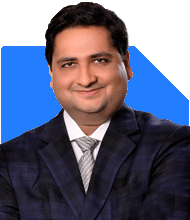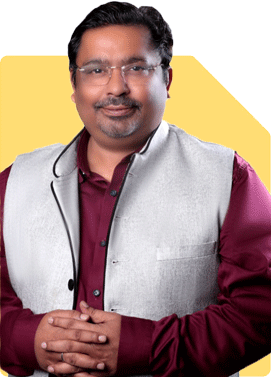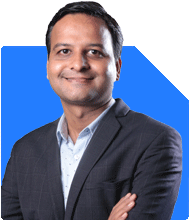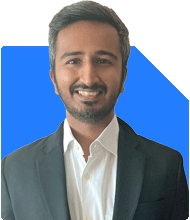Hardik Parikh | Answer |Ask -Follow
Tax, Mutual Fund Expert - Answered on Apr 07, 2023
He also holds an MBA degree from IIM-Indore.
Hardik, who began his career as an equity research analyst, founded his own advisory firm, Hardik Parikh Associates LLP, which provides a variety of financial services to clients.
He is committed to sharing his knowledge and helping others learn more about finance. He also speaks about valuation at different forums, such as study groups of the Western India Regional Council of Chartered Accountants.... more

Hello Sir , My Self Manoj ,I am 40 years old a salaried person , and investing in MFs Since 5.5 years I have below current ongoing investments Aditya Birla FlexiCap Fund -- 7000 p.m.(SIP) HDFC Midcap Opportunities fund ---4000 p.m.(SIP) HDFC Hybrid Equity Fund ----2000 p.m.(SIP) DSP mid cap fund ---2000 p.m.(SIP) DSP Select Focus Fund ---2000 p.m.(SIP) DSP Small Cap Fund 3000 p.m.(SIP) Kotak Equity Opportunities Fund ---2000 p.m.(SIP) SBI Blue Chip Fund -----64000 (lumpsome) SBI Small cap fund ----2000 p.m.(SIP) Nippon India small cap fund ----2000 p.m.(SIP) Invesco Small cap fund ---1000 p.m.(SIP) Tata Small cap fund ----1000 p.m.(SIP) Mahindra Unnati Emerginf Business yojana ----2000 p.m.(SIP) Tata Balanced Advantage Fund -----50000 Mirae Asset Mid cap Fund ---2000 p.m.(SIP) ICICI Flexicap fund -----70000 (lumpsome) DSP Equity and Bond Fund---- 32000 (lumpsome) DSP Dynamic Asset Allocation Fund ----23000 (lumpsome) Sundaram Emerging small cap series1---17000 (lumpsome) Sundaram Services Fund---500 p.m.(SIP) Tata Flexicap Fund ----17400 (lumpsome) Baroda BNP Paribas Flexicap Fund ----50000 (lumpsome) Icici Blue chip Fund ---400 p.m.(SIP) Edelweiss small cap fund ----2000 p.m.(SIP) Axis Flexicap Fund ----19000 (lumpsome) Sundaram Small cap fund ----98000 (lumpsome) ICICI mnc fund---- 6000 (lumpsome) Axis mid cap fund ---500 p.m.(SIP) Canara Robeco small cap fund -----1000 p.m.(SIP) BOI small cap fund ----1000 p.m.(SIP) Aditya birla multicap fund----50000 (lumpsome) Kotak Multicap fund -----25000 (lumpsome) HDFC world indexes fund of fund---10000 (lumpsome) SBI Multicap fund ---1000 p.m.(SIP) PGIM India mid cap oppportunities fund ---1000 p.m.(SIP) Axis small cap fund ----500 p.m.(SIP) Edelweiss focused equity fund ---21000 (lumpsome) UTI flexicap fund ---3000 p.m.(SIP) Quant Large cap fund ---25000 (lumpsome) IDFC mid cap fund ---25000 (lumpsome) White Oak mid cap fund ---20000 (lumpsome) Sundaram Flexicap fund ---700 (lumpsome) Canara Robeco mid cap fund ---2000 p.m.(SIP) Mahindra small cap fund---2000 p.m.(SIP) Total amount of SIP is roughly around 45k per month, Since December 2016 till the date now my investment corpus in Mutual Fund has been now 30.5 lakhs , also i have 30k invested in direct stocks in Indian equity Market. I have 3 LIC policies and 1 term insurance policy of 1 crore cover,I have Bank FDs in nationalised bank for about 27 lakhs , and 3 lakhs in PPF My Goals are 1) 2 crores for my children's marriage and education 2) 2 crores for buying home 3) 4 crores for retirement life (after 10 years) In total i want to generate 8 crores in next 10 years. Kindly suggest if i would be able to achieve the goals in next 10 years,and changes if required any Regards Manoj
It's great to see that you've been disciplined with your investments and have built a sizable corpus already. To assess if your current investments will help you achieve your goals of 8 crores in the next 10 years, let's take a closer look at your financial situation and goals.
Current Investments:
Mutual Funds: ~30.5 lakhs
Direct stocks: 30k
LIC policies and term insurance: Not considered for investment purposes
Bank FDs: 27 lakhs
PPF: 3 lakhs
Total: ~60.5 lakhs
Monthly SIP investments: ~45k
Now let's analyze your goals:
Children's marriage and education: 2 crores
Buying a home: 2 crores
Retirement life (in 10 years): 4 crores
Total: 8 crores
Assuming an average annual return of 12% on your equity investments, here's a rough projection of your portfolio's growth:
Current investments (60.5 lakhs) in 10 years: ~1.87 crores
Monthly SIPs (45k) in 10 years: ~1.05 crores
Total: ~2.92 crores
Based on this calculation, you would not reach your goal of 8 crores in the next 10 years. However, you can consider making some changes to improve your chances:
Reassess your goals: Consider if your goals are realistic and if there's any flexibility in the amounts or timelines.
Increase your SIP investments: As your salary increases, try to increase your SIP investments to accelerate your portfolio's growth.
Rebalance your portfolio: Regularly review your portfolio to ensure it's aligned with your risk appetite and financial goals. This may involve reducing the number of funds or shifting the allocation between equity and debt.
Monitor fund performance: Keep an eye on the performance of your funds and consider replacing underperforming ones.
Remember that financial planning is an ongoing process, and it's essential to periodically review and adjust your strategy. It's also a good idea to consult with a professional financial advisor to get personalized advice for your specific situation. While it might be challenging to achieve 8 crores within 10 years, these suggestions may help you get closer to your goals.
Best regards,
You may like to see similar questions and answers below
Omkeshwar Singh | Answer |Ask -Follow
Head, Rank MF - Answered on Sep 08, 2021
Ulhas Joshi |280 Answers |Ask -Follow
Mutual Fund Expert - Answered on Jun 22, 2023
Vivek Lala |323 Answers |Ask -Follow
Tax, MF Expert - Answered on Oct 09, 2023
Ramalingam Kalirajan |10872 Answers |Ask -Follow
Mutual Funds, Financial Planning Expert - Answered on May 15, 2024
Nayagam P P |10852 Answers |Ask -Follow
Career Counsellor - Answered on Dec 07, 2025

Research Career Prospects: IISc, IITs, and Beyond: For research-oriented careers, the Integrated M.Sc Physics program at Amrita provides an exceptional foundation. Amrita's curriculum specifically aligns with GATE and UGC-NET examination syllabi, and the institution emphasizes early research engagement. The faculty at Amrita actively publish research in Scopus-indexed journals, with over 60 publications in international venues within the past five years, exposing you to active research environments.
To pursue research at premier institutions like IISc, you would typically follow the PhD pathway. IISc accepts M.Sc graduates through their Integrated PhD programs, and with your Amrita M.Sc, you're eligible to apply. You'll need to qualify the relevant entrance examinations, and your integrated program's emphasis on research fundamentals provides strong preparation. The final year of your Integrated M.Sc is intentionally structured to be nearly free of classroom commitments, enabling engagement with research projects at institutes like IISc, IITs, and National Labs. According to Amrita's data, over 80% of M.Sc Physics students secured internship offers from reputed institutions during academic year 2019-20, directly facilitating research career transitions.
Placement and Direct Employment Opportunities: Amrita University boasts a comprehensive placement ecosystem with strong corporate and government sector connections. According to NIRF placement data for the Amrita Integrated M.Sc program (5-year), the median salary in 2023-24 stood at ?7.2 LPA with approximately 57% placement rate. However, these figures reflect general placement trends; physics graduates often secure higher packages in specialized technical roles. Many graduates join software companies like Infosys (with early offers), Google, and PayPal, where their strong analytical and computational skills command competitive compensation packages ranging from ?8-15 LPA for entry-level positions.
The Department of Corporate and Industrial Relations at Amrita provides intensive three-semester life skills training covering linguistic competence, data interpretation, group discussions, and interview techniques. This structured placement support significantly enhances your employability in both government and private sectors.
Government Sector Opportunities: UPSC, BARC, DRDO, and ISRO: Your M.Sc Physics degree opens multiple avenues for prestigious government employment. UPSC Geophysicist examinations explicitly list M.Sc Physics or Applied Physics as qualifying degrees, enabling you to compete for Group A positions in the Geological Survey of India and Central Ground Water Board. The age limit for geophysicist positions is 32 years (with relaxation for reserved categories), and the exam comprises preliminary, main, and interview stages.
BARC (Bhabha Atomic Research Centre) actively recruits M.Sc Physics graduates as Scientific Officers and Research Fellows. Recruitment occurs through the BARC Online Test or GATE scores, with positions in nuclear science, radiation protection, and atomic research. BARC Summer Internship programs are available, offering ?5,000-?10,000 monthly stipends with opportunity for future scientist recruitment.
DRDO (Defense Research and Development Organization) recruits M.Sc Physics graduates through CEPTAM examinations or GATE scores for roles involving defense technology, weapon systems, and laser physics research. ISRO (Indian Space Research Organisation) regularly advertises scientist/engineer positions through competitive recruitment for candidates with strong physics backgrounds, offering opportunities in satellite technology and space science applications.
Other significant employers include the Indian Meteorological Department (IMD) recruiting as scientific officers, and NPCIL (Nuclear Power Corporation of India Limited), offering stable government service with competitive compensation packages exceeding ?8-12 LPA for scientists.
Alternate Career Pathways: UPSC, CDS, and AFCAT: UPSC Civil Services (IFS - Indian Forest Service): M.Sc Physics graduates qualify for UPSC Civil Services examinations, with the forest service offering opportunities for science-based administrative roles with potential to reach senior government positions.
CDS/AFCAT (Armed Forces): While AFCAT meteorology branches specifically require "B.Sc with Maths & Physics with 60% minimum marks," the technical branches (Aeronautical Engineering and Ground Duty Technical roles) require graduation/integrated postgraduation in Engineering/Technology. An M.Sc Physics integrates well with technical qualifications, though you would need engineering background for direct officer entry. However, you remain eligible for specialized technical interviews if applying through alternate defence channels.
UGC-NET Examination: This pathway leads to Assistant Professor positions in central universities and colleges across India. NET-qualified candidates receive scholarships of ?31,000/month for 2-year JRF positions with PhD pursuit, transitioning to Assistant Professor salaries of ?41,000/month in government institutions. This route provides long-term academic career security with research opportunities.
Private Sector Technical Roles
M.Sc Physics graduates are increasingly valued in data science, software engineering, and technical consulting. Companies actively recruit physics graduates for software development, where strong problem-solving and logical reasoning translate to competitive packages of ?10-20 LPA. Specialized domains including quantum computing development, financial modeling, and scientific computing offer premium compensation. Your minor in Scientific Computing makes you particularly attractive to technology companies requiring computational expertise.
International Opportunities and Higher Studies Abroad
An M.Sc from Amrita facilitates admission to PhD programs at international institutions. German universities offer tuition-free or low-fee MSc Physics programs (2 years) with scholarships like DAAD providing €850+ monthly stipends. US universities accept M.Sc graduates directly for PhD positions with full funding (tuition coverage + stipend). These pathways require GRE scores and strong Statement of Purpose articulating research interests. Research collaboration opportunities exist with Max Planck Institute (Germany) and CalTech Summer Research Program (USA), both welcoming Indian M.Sc students.
Essential Skills and Certifications to Develop Immediately: Programming Languages: Start learning Python immediately—it's universally used in research and industry. Dedicate 2-3 hours weekly to data analysis, scientific computing libraries (NumPy, SciPy, Pandas), and machine learning fundamentals. MATLAB is equally critical for physics applications, particularly numerical simulations and data visualization. Aim to complete MATLAB certification courses within your first year.
Research Tools: Learn Git/version control, LaTeX for scientific documentation, and data analysis frameworks. These skills are indispensable for publishing research papers and collaborating on projects.
Certifications Worth Pursuing: (1) MATLAB Certification (DIYguru or MathWorks official courses) (2) Python for Data Science (complete certificate programs from platforms like Coursera) (3) Machine Learning Fundamentals (for expanding technical versatility) & (4) Scientific Communication and Technical Writing (develop through departmental workshops)
Strategic Internship Planning: Leverage Amrita's research connections systematically. In your third year, apply to BARC Summer Internship, IISER Internships, TIFR Summer Fellowships, and IIT Internship programs (like IIT Kanpur SURGE). These expose you to frontier research while establishing connections for future PhD or scientist recruitment. Target 2-3 research internships across different specializations to develop versatility.
TO SUM UP, Your Integrated M.Sc Physics degree from Amrita positions you exceptionally well for competitive research careers at IISc/IITs, prestigious government scientist roles at BARC/DRDO/ISRO, and international PhD opportunities. The program's scientific computing emphasis differentiates you in the job market. Immediate priorities: (1) Master Python and MATLAB within the first two years; (2) Engage in research projects starting year 2-3; (3) Target internships at premiere research institutions; (4) Prepare GATE while completing your degree for maximum flexibility in recruitment; (5) Consider UGC-NET for long-term academic stability. Your career trajectory will ultimately depend on developing strong research fundamentals, demonstrating consistent excellence in specialization areas, and strategically selecting internship and research opportunities. The rigorous Amrita program combined with disciplined skill development positions you for exceptional career success across multiple sectors. Choose the most suitable option for you out of the various options available mentioned above. All the BEST for Your Prosperous Future!
Follow RediffGURUS to Know More on 'Careers | Money | Health | Relationships'.
Nayagam P P |10852 Answers |Ask -Follow
Career Counsellor - Answered on Dec 07, 2025
Radheshyam Zanwar |6736 Answers |Ask -Follow
MHT-CET, IIT-JEE, NEET-UG Expert - Answered on Dec 06, 2025

Good luck.
Follow me if you receive this reply.
Radheshyam
Dr Nagarajan J S K |2576 Answers |Ask -Follow
NEET, Medical, Pharmacy Careers - Answered on Dec 06, 2025
Mihir Tanna |1090 Answers |Ask -Follow
Tax Expert - Answered on Dec 06, 2025
Ramalingam Kalirajan |10872 Answers |Ask -Follow
Mutual Funds, Financial Planning Expert - Answered on Dec 06, 2025
Radheshyam Zanwar |6736 Answers |Ask -Follow
MHT-CET, IIT-JEE, NEET-UG Expert - Answered on Dec 06, 2025
Radheshyam Zanwar |6736 Answers |Ask -Follow
MHT-CET, IIT-JEE, NEET-UG Expert - Answered on Dec 06, 2025
Radheshyam Zanwar |6736 Answers |Ask -Follow
MHT-CET, IIT-JEE, NEET-UG Expert - Answered on Dec 06, 2025
Dr Dipankar Dutta |1837 Answers |Ask -Follow
Tech Careers and Skill Development Expert - Answered on Dec 05, 2025




























